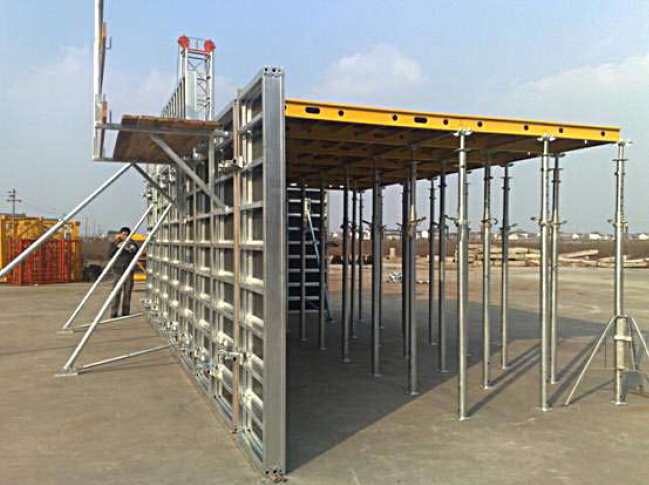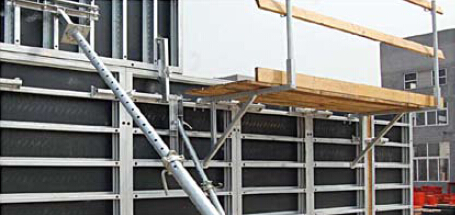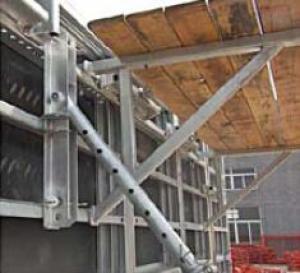Steel Frame working platformfor Formwork and Scaffolding system
- Loading Port:
- Tianjin
- Payment Terms:
- TT OR LC
- Min Order Qty:
- 50 m²
- Supply Capability:
- 1000 m²/month
OKorder Service Pledge
OKorder Financial Service
You Might Also Like
Steel-frame Formwork SF-140
Characteristics:
◆ Few parts for fast forming.
◆ Max. Concrete pressure: 80KN/m2.
◆ Hot-dip galvanized steel frame.
◆ The thickness of plywood is 18mm & the panel is 14cm.
◆ Compatibility with Hunnebeck Manto system due to similar edge profile.
System Details & Application:
◆ Neat joint and fast assembling with aligning panel clamp.
◆ Flexible panel arrangement and height extension.
◆ The selection of panels.
◆ Kinds of panel connectors.
◆ Corner clamp application.
◆ Length adjustment application.
◆ Height adjustment & aligning strut.
◆ Walkway bracket & platform.


- Q:Can steel formwork be used in combination with other types of formwork?
- Yes, steel formwork can be used in combination with other types of formwork. In construction projects, it is common to use a combination of different types of formwork to meet the specific requirements of the structure being built. Steel formwork offers several advantages, such as durability, reusability, and high load-carrying capacity. It is often used for large-scale projects or structures with complex geometries. However, steel formwork can be expensive and heavier compared to other types of formwork. In situations where speed and efficiency are crucial, contractors may choose to use a combination of steel formwork with other types of formwork, such as timber or aluminum. This allows for a more cost-effective approach while still maintaining the desired strength and stability. For example, timber formwork may be used for simpler sections of the structure or areas where the load is relatively light. This can help reduce costs and make the overall construction process more efficient. Steel formwork, on the other hand, can be utilized for critical areas that require higher load-carrying capacity or more complex shapes. The combination of different types of formwork also provides flexibility in terms of design and construction methods. By using steel formwork in combination with other types, contractors can optimize the use of resources, minimize costs, and ensure the successful completion of the project. However, it is important to note that when using a combination of formwork types, proper coordination and planning are essential. Contractors need to ensure that the different types of formwork are compatible and adequately supported to maintain structural integrity. Additionally, proper safety measures should be implemented to protect workers during the construction process. Overall, steel formwork can be effectively used in combination with other types of formwork to achieve the desired construction goals, improve efficiency, and optimize resource utilization.
- Q:How does steel formwork compare to aluminum formwork?
- In construction projects, two popular types of formwork systems are utilized: steel formwork and aluminum formwork. While both options have their pros and cons, several notable distinctions set them apart. Strength and Durability: Steel formwork boasts exceptional strength and durability, making it ideal for heavy-duty construction projects. It can withstand high load capacities and is resistant to deformation. Conversely, aluminum formwork, although lighter, lacks the same level of strength as steel. It is more suitable for smaller-scale projects that do not require heavy loads. Weight and Handling: Steel formwork is significantly heavier than aluminum formwork. This disparity can make transportation and handling more challenging, demanding more labor and machinery. On the other hand, aluminum formwork, being lightweight, is easier to handle and transport, minimizing the need for additional resources. Cost: Steel formwork tends to be pricier than aluminum formwork due to its superior strength and durability. However, steel formwork has a longer lifespan and can be reused multiple times, potentially making it more cost-effective in the long run. In contrast, aluminum formwork is cheaper initially but may necessitate more frequent replacement due to its lower durability. Versatility and Adaptability: Steel formwork can be tailored to fit various shapes and sizes, providing greater design flexibility. It is highly adaptable, allowing for on-site modifications if necessary. Conversely, aluminum formwork is less versatile and typically comes in standard sizes. Consequently, more planning and precision are required during the design phase. Surface Finish: Steel formwork typically yields a smoother and more uniform surface finish compared to aluminum formwork. This is crucial for projects where the appearance of concrete elements is of utmost importance, such as architectural structures. Environmental Impact: Aluminum formwork is considered more environmentally friendly than steel formwork. Aluminum can be recycled and reused more easily, thus reducing its carbon footprint. Conversely, steel requires more energy and resources for production and recycling. In conclusion, steel formwork and aluminum formwork each possess distinct advantages and disadvantages. Steel formwork excels in strength, durability, and surface finishes but is heavier, costlier, and less environmentally friendly. On the other hand, aluminum formwork is lighter, cost-effective, and easier to handle but lacks equal strength and durability. Ultimately, the choice between the two depends on the specific requirements of the construction project and the priorities of the contractor or builder.
- Q:How does steel formwork handle different concrete durability requirements?
- Steel formwork is highly versatile and can easily handle different concrete durability requirements. It provides a reliable and durable framework for concrete casting, ensuring consistent and precise results. Steel formwork can withstand the pressure of fresh concrete without deforming, which is essential for achieving the desired shape and finish of the concrete structure. Additionally, steel formwork can be easily adjusted and reused, making it suitable for various construction projects with different durability requirements. Whether the concrete needs to withstand heavy loads, extreme weather conditions, or have a longer service life, steel formwork can efficiently accommodate these requirements and help in achieving the desired durability of the concrete structure.
- Q:How does steel formwork handle different concrete surface repair techniques?
- Steel formwork is highly versatile and can easily accommodate various concrete surface repair techniques. Its strong and durable structure allows for the application of techniques such as surface grinding, shot blasting, or sandblasting to remove damaged or deteriorated concrete. Additionally, steel formwork provides a smooth and stable surface, enhancing the effectiveness of techniques like patching, skim coating, or the application of bonding agents. Overall, steel formwork is compatible with a wide range of concrete surface repair techniques, making it a reliable choice for handling such repairs.
- Q:How does steel formwork affect the overall strength of the structure?
- Steel formwork can significantly enhance the overall strength of a structure. Its robust and durable nature ensures that the concrete is cast and supported effectively, resulting in a more stable and solid construction. Steel formwork provides excellent reinforcement and support to the concrete during the curing process, preventing any deformation or cracking. Additionally, its high load-bearing capacity allows for the construction of taller and more complex structures, thereby increasing the overall strength and integrity of the building.
- Q:Can steel formwork be used in cold weather conditions?
- Yes, steel formwork can be used in cold weather conditions. Steel is a durable and strong material that can withstand low temperatures without losing its structural integrity. However, it is important to take appropriate precautions such as preventing the steel from coming into direct contact with moisture to avoid potential issues like rusting.
- Q:What are the different types of ties used in steel formwork construction?
- There are several types of ties commonly used in steel formwork construction, including steel wire ties, snap ties, wedge ties, and coil ties. Each type of tie is designed to securely hold the formwork together and provide stability during the concrete pouring process. Steel wire ties are typically used for light-duty applications, while snap ties, wedge ties, and coil ties are more commonly used for heavy-duty formwork construction.
- Q:What are the different types of accessories used with steel formwork?
- There are various types of accessories that are commonly used with steel formwork to enhance its functionality and effectiveness in construction projects. Some of the different types of accessories used with steel formwork include: 1. Formwork Wedges: These are small wedges made of steel or plastic that are used to secure the formwork panels together. They help in maintaining the accurate alignment and stability of the formwork system during concrete pouring. 2. Formwork Clamps: Clamps are used to hold the formwork panels in place and prevent any movement or displacement during the pouring and curing of concrete. They are typically made of steel and are available in different sizes and designs to suit various formwork requirements. 3. Formwork Ties: Ties are used to connect the formwork panels and provide structural stability to the formwork system. They can be either steel or plastic and are available in different lengths and types, such as snap ties, wedge ties, and loop ties. 4. Formwork Braces: Braces are used to reinforce and strengthen the formwork system. They are typically made of steel and are used to support the formwork panels and prevent any bending or deformation during the concrete pouring process. 5. Formwork Hangers: Hangers are used to suspend the formwork panels at the desired height and provide support. They are typically made of steel and are adjustable to accommodate different formwork heights and configurations. 6. Formwork Spacers: Spacers are used to maintain the desired spacing between the formwork panels and ensure uniformity in the thickness of the concrete walls or slabs. They are typically made of plastic or steel and are available in various sizes and shapes. 7. Formwork Release Agents: Release agents are used to prevent the adhesion of concrete to the formwork surface. They are applied to the formwork panels before the concrete is poured, allowing for easy removal of the formwork once the concrete has cured. Overall, these accessories play a crucial role in ensuring the stability, alignment, and functionality of steel formwork systems. They contribute to the efficiency and quality of construction projects by providing reliable support and reinforcement to the formwork during the concrete pouring process.
- Q:How does steel formwork contribute to the overall efficiency of concrete construction?
- Steel formwork contributes to the overall efficiency of concrete construction by providing a durable and reusable framework for pouring concrete. It offers a high level of accuracy and precision in shaping the concrete, ensuring that the desired dimensions and finishes are achieved. This leads to a reduction in material wastage and labor costs. Additionally, the strength and stability of steel formwork allows for faster construction cycles, enabling projects to be completed on time or ahead of schedule.
- Q:How does steel formwork perform in different weather conditions?
- Steel formwork performs well in different weather conditions. It is highly resistant to extreme temperatures, moisture, and UV radiation. This makes it suitable for use in both hot and cold climates. Steel formwork maintains its structural integrity and durability, ensuring consistent performance even in harsh weather conditions. Additionally, its non-absorbent nature prevents water damage or warping, making it a reliable choice for construction projects in various weather conditions.
1. Manufacturer Overview |
|
|---|---|
| Location | |
| Year Established | |
| Annual Output Value | |
| Main Markets | |
| Company Certifications | |
2. Manufacturer Certificates |
|
|---|---|
| a) Certification Name | |
| Range | |
| Reference | |
| Validity Period | |
3. Manufacturer Capability |
|
|---|---|
| a)Trade Capacity | |
| Nearest Port | |
| Export Percentage | |
| No.of Employees in Trade Department | |
| Language Spoken: | |
| b)Factory Information | |
| Factory Size: | |
| No. of Production Lines | |
| Contract Manufacturing | |
| Product Price Range | |
Send your message to us
Steel Frame working platformfor Formwork and Scaffolding system
- Loading Port:
- Tianjin
- Payment Terms:
- TT OR LC
- Min Order Qty:
- 50 m²
- Supply Capability:
- 1000 m²/month
OKorder Service Pledge
OKorder Financial Service
Similar products
New products
Hot products
Related keywords























